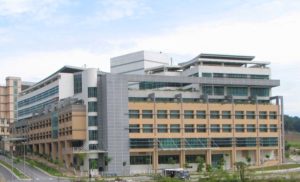
The Ministry of Energy, Water & Communications (MEWC) have moved into their new Low Energy Office Building, LEO Building, in Putrajaya Malaysia in September 2004. This building is a National Demonstration project aimed at promoting energy efficiency (EE) in buildings, and the project is part of a wider program aimed at developing the capacity of the Malaysian building industry in EE building design.
The target for the Energy Index of the 17,800m² building (A/C area) is an equivalent electricity consumption of 100kWh/m2year. Among the energy saving features are well insulated walls and roof, exterior window shading, energy efficient lighting controlled according to occupancy and daylight availability, energy efficient office equipment, a comprehensive energy management system, and implementation of a series of best practice solutions for the mechanical and electrical systems. The building also demonstrates use of renewable energy, as a 3-kWp grid connected photovoltaic system is installed on the roof.
The building is designed to meet and in some area exceed the standard of MS 1525: Code of Practice for Energy Efficiency and Renewable Energy in non-domestic building. This entails, that the building is designed for an illumination level of 300 – 400lux. Installed lighting and small power loads are each reduced to approximately 8 W/m², compared to a typical load of 15 – 20W/m² for each respectively.
The extra cost for the energy efficiency features in the LEO building is 10% on top of the normal construction costs, or RM 5 million. The energy savings compared to traditional design without energy efficiency features are 100 – 150kWh/m²year. The estimated payback time is thus less than 10 years, with the current price of electricity in Malaysia of 0.29 RM/kWh.
Savings Narrative:
Highlights of the building is the atrium where it is naturally lit and ventilated by a glazed roof and internal landscaping water feature for evaporative cooling of this space. This building was also built to meet the Malaysian Standard MS 1525 of attaining an energy consumption of 135 kWh/m² per year or lower. The building currently recorded an energy consumption of close to 100 kWh/m2 per year. This energy index is lower than a typical new office building in Malaysia (energy index between 200 – 300 kWh/m² per year).